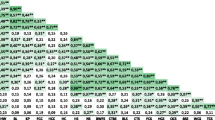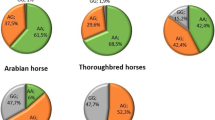Abstract
The predisposition of horses to nasal bleeding significantly affects their performance and requires special control, particularly in the breeding work aimed at improving the breed and increasing its working abilities. One of the causes of such bleeding is spontaneous nucleotide substitutions in the D'-D3 domain of the von Willebrand factor. The presence and distribution of mutations in the D'-D3 domain of this factor (c.2826 A > C in exon 22, leading to the replacement of lysine by asparagine) in Russian horse breeds (Russian Trotter, Russian Saddle horse, Russian Heavyweight, Altai, and Karachai horse breeds) were analyzed. The highest frequency of this replacement was found in the Russian Trotter and Russian Heavyweight. We aimed to clarify the possible association of this mutation spread with the population and genetic relationship between horse breeds. The polylocus genotyping of 26 genomic DNA fragments flanked by inverted repeats sections of microsatellites (GA)9C, (AG)9C, and (GAG)6C (Inter Simple Sequence Repeats—ISSR-PCR markers) was performed, genetic distances were calculated, and corresponding dendrograms were constructed. It was found that the prevalence of the detected mutation is not related to the population and genetic proximity of the breeds. Historically, the Orlov horse breed had been involved in the breeding of the Russian Trotter and Russian Heavyweight. Therefore, it is possible that the high frequency of this mutation in the Russian Trotter and the Russian Heavyweight may be due to its presence in the Orlov horse breed that was the source for these breeds.

Similar content being viewed by others
REFERENCES
Poole, D.C. and Erickson, H.H., Exercise-induced pulmonary hemorrhage: Where are we now?, Vet. Med. Res. Rep., 2016, vol. 7, pp. 133–148.
Tang, W., Cushman, M., Green, D., Rich, S.S., Lange, L.A., Yang, Q., Tracy, R.P., Tofler, G.H., Basu, S., Wilson, J.G., Keating, B.J., Weng, L.C., Taylor, H.A., Jacobs, Jr.D.R., Delaney, J.A., et al., Gene centric approach identifies new and known loci for F VIII activity and VWF antigen levels in European Americans and African Americans, Am. J. Hematol., 2015, vol. 90, no. 6, pp. 534–540.
Sadler, J.E., Budde, U., Eikenboom, J.C.J., Favaloro, E.J., Hill, F.G.H., Ingerslve, J., Lee, C.A., Lillicrap, D., Mannucci, P.M., Mazurier, C., Meyer, D., Nichols, W.L., Nishino, M., Peake, I.R., Rodeghiero, F., et al., Update on the pathophysiology and classification of von Willebrand disease: A report of the Subcommittee on von Willebrand Factor, J. Thromb. Haemostasis, 2006, vol. 4, no. 10, pp. 2103–2114.
Norton, E.M., Wooldridge, A.A., Stewart, A.J., Cusimano, L., Schwartz, D.D., Johnson, C.M., Boudreaux, M.K., and Christopherson, P.W., Abnormal coagulation factor VIII transcript in a Tennessee Walking Horse colt with hemophilia A, Vet. Clin. Pathol., 2016, vol. 45, no. 1, pp. 96–102.
Berber, E., Fidanci, I.D., Un, C., Maarri, O., Aktuglu, G., Gurgey, A., Celkan, T., Meral, A., Oldenburg, J., Graw, J., Akar, N., and Caglayan, H., Sequencing of the factor 8 (F8) coding regions in 10 Turkish hemophilia A patients reveals three novel pathological mutations, and one rediagnosis of von Willebrand’s disease type 2N, Haemophilia, 2006, vol. 12, no. 4, pp. 398–400.
Casonato, A., Galletta, E., Sarolo, L., and Daidone, V., Type 2N von Willebrand disease: Characterization and diagnostic difficulties, Haemophilia, 2018, vol. 24, no. 1, pp. 134–140.
Hampshire, D.J. and Goodeve, A.C., The international society on thrombosis and haematosis von Willebrand disease database: An update, Sem. Thromb. Hemostasis, 2011, vol. 37, no. 5, pp. 470–479.
Ginsburg, D. and Sadler, E.J., Von Willebrand disease: A database of point mutations, insertions, and deletions. For the Consortium on von Willebrand Factor Mutations and Polymorphisms, and the Subcommittee on von Willebrand Factor of the Scientific and Standardization Committee of the International Society on Thrombosis and Haemostasis, Thromb. Haemostasis, 1993, vol. 70, no. 2, p. 69.
Kroner, P.A., Friedman, K.D., Fahs, S.A., Scott, J.P., and Montgomery, R.R., Abnormal binding of factor VIII is linked with the substitution of glutamine for arginine 91 in von Willebrand factor in a variant form of von Willebrand disease, J. Biol. Chem., 1991, vol. 266, no. 29, pp. 19146–19149.
Mazurier, C., Goudemand, J., Hilbert, L., Caron, C., Fressinaud, E., and Meyer, D., Type 2N von Willebrand disease: Clinical manifestations, pathophysiology, laboratory diagnosis and molecular biology, Best Pract. Res. Clin. Haematol., 2001, vol. 14, no. 2, pp. 337–347.
Wang, Q.Y., Song, J., Gibbs, R.A., Boerwinkle, E., Dong, J.F., and Yu, F.L., Characterizing polymorphisms and allelic diversity of von Willebrand factor gene in the 1000 genomes, J. Thromb. Haemostasis, 2013, vol. 11, no. 2, pp. 261–269.
Trommershausen-Smith, A., Aspects of genetics and disease in the horse, J. Anim. Sci., 1980, vol. 51, no. 5, pp. 1087–1095.
Brooks, M., Leith, G.S., Allen, A.K., Woods, P.R., Benson, R.E., and Dodds, W.J., Bleeding disorder (von Willebrand disease) in a quarter horse, J. Am. Vet. Med. Assoc., 1991, vol. 198, no. 1, pp. 114–116.
Golik, T.V., Erkenov, T.A., Glazko, T.T., and Glazko, V.I., Spectra of ISSR-PCR markers in estimates of the population-genetic differentiation of the Karachay horse in the farms of the Karachay-Cherkess Republic, Izv. Timiryazevsk. S-kh. Akad., 2018, no. 3, pp. 61–77.
Parfenov, V.A. and Khotov, V.Kh., Gosudarstvennaya plemennaya kniga loshadei karachaevskoi porody (The State Pedigree Book of the Karachay Horse), Moscow: Izd. RGAU-MSKhA im. K. A. Timiryazeva, 2010.
Lobanova, T.V. and Trushnikov, V.A., The Altai horse and the stages of its transformation, Vestn. Altai. Gos. Agrarn. Univ., 2005, no. 1, pp. 84–87.
Kambegov, B.D., Balakshin, O.A., and Khotov, V.Kh., Loshadi Rossii: Polnaya entsiklopediya (Horses of Russia: Complete Encyclopedia), Moscow: RITs MDK, 2002.
Norton, E., Mutational analysis and coagulation factor VIII sequence in a colt with hemophilia A, PhD Thesis, 2013. http://hdl.handle.net/10415/3686.
Zietkiewicz, E., Rafalski, A., and Labuda, D., Genome fingerprinting by secuence repeat (SSR) anchored polymerase chain reaction amplification, Genomics, 1994, vol. 20, no. 2, pp. 176–183.
Botstein, D., White, R.L., Skolnick, M., and Davis, R.W., Construction of a genetic linkage map in man using restriction fragment length polymorphism, Am. J. Hum. Genet., 1980, vol. 32, no. 3, pp. 314–331.
Nei Masatoshi, Genetic distance between populations, Am. Nat., 1972, vol. 106, no. 949, pp. 283–292.
Bellissimo, D.B., Christopherson, P.A., Flood, V.H., Gill, J.C., Friedman, K.D., Haberichter, S.L., Shapiro, A.D., Abshire, T.C., Leissinger, C., Hoots, W.K., Lusher, J.M., and Ragni, M.V., VWF mutations and new sequence variations identified in healthy controls are more frequent in the African-American population, Blood, 2012, vol. 119, no. 9, pp. 2135–2140.
Author information
Authors and Affiliations
Corresponding author
Ethics declarations
Conflict of interests. The authors declare that they have no conflict of interest.
Statement on the welfare of animals. All applicable international, national, and/or institutional guidelines for the care and use of animals were followed.
Additional information
Translated by I. Shipounova
About this article
Cite this article
Glazko, V.I., Erkenov, T.A., Alrafy, R. et al. Predisposition to Nasal Bleeding in Horses. Russ. Agricult. Sci. 45, 571–575 (2019). https://doi.org/10.3103/S1068367419060090
Received:
Revised:
Accepted:
Published:
Issue Date:
DOI: https://doi.org/10.3103/S1068367419060090




